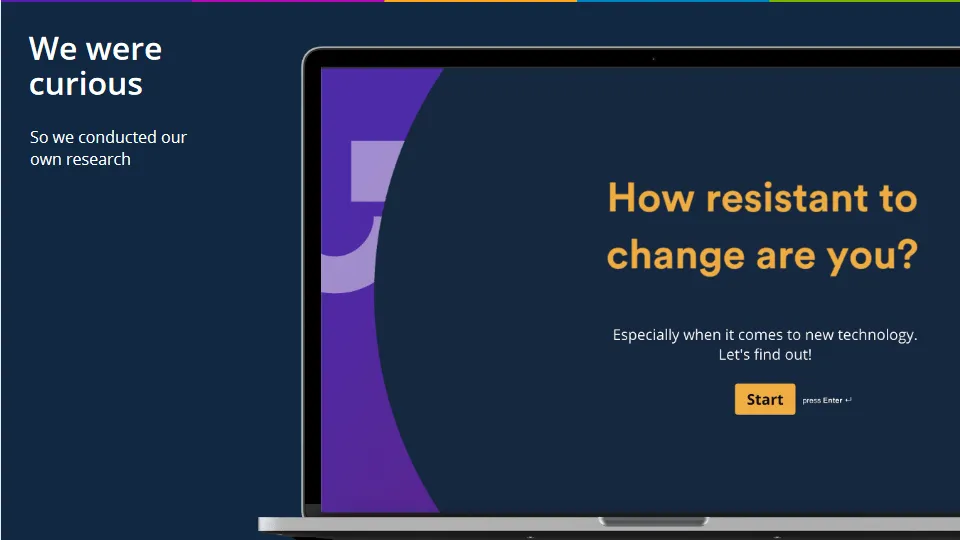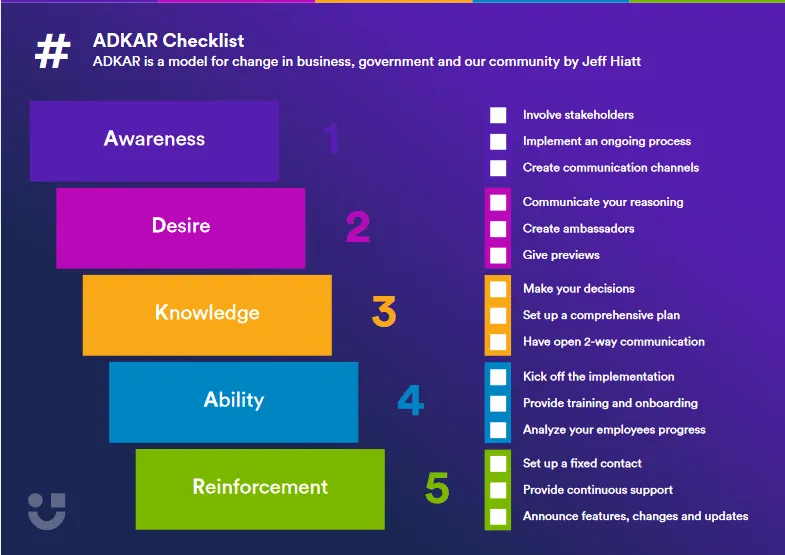Resistance to Adoption: Get People on Board With Change

On the 1 October 2020, our CEO and Co-Founder Hartmut Hahn gave a talk at Europe’s largest tech event, TNW (The Next Web)! TNW is all about driving innovation, exploring new technologies, and connecting the world’s brightest minds; and this is something we, at Userlane, do too! We’re all about driving digital transformation and taking companies to new heights with our interactive guidance software and industry expertise.
The topic of Hartmut’s talk was, “From Resistance to Adoption: How to Get Employees on Board With Change,” and in the weeks leading up to the event, we conducted a survey evaluating how resistant people are to change when it comes to the introduction of new technologies in the workplace.
So for this blog post, we’re going to share some of the (interesting) results from the survey as well as provide a few takeaways from Hartmut’s talk. We hope you enjoy the insights provided!
Table of Contents
Resistance to Change Demystified: Survey Results
To make the results of the survey even more interesting, we decided to use them to “debunk” some of the myths surrounding resistance to change (maybe Userlane should appear on an episode of MythBusters ????). Below are three myths, so let’s see what we debunked!

Myth 1: People just don’t like change
Question asked in survey:
Are you always happy about new software and innovations introduced at work?
Results:
41.8% of participants said yes, it’s exciting to learn new things; and 39.3% said yes, but only when there is a clear need for this technology.
Status:
Myth debunked! People DO like change, but they will need to see a reason behind the need for it!
Myth 2: People fear being replaced
Question asked in survey:
What’s your main concern when it comes to new software or technology introduced at work?
Results:
43.8% responded that they don’t have any concerns, just positive vibes! Only 3.8% said that they wonder if technology will replace them at some point.
Status:
Myth debunked! Employees DON’T fear being replaced by technology!
Myth 3: There’s nothing you can do about resistance
Question asked in survey:
What would help you most to be more optimistic about new software and innovation at work?
Results:
50.2% said understanding what the new software is for and what its business impact will be would help the most. 29.7% said that training materials and proper guidance would also be beneficial.
Status:
Myth debunked! There IS something companies can do about resistance, and based on the survey, it largely comes down to communicating the WHY behind the change.
Resistance is Futile! Your Own ADKAR Checklist
One of the most effective ways to handle resistance to change in any organization is to use the ADKAR change management model, which is designed to support employees moving through change and improve organizational outcomes. This goal-oriented model was created by Jeff Hiatt and represents “five tangible and concrete outcomes that people need to achieve for lasting change.” These are A for awareness of the need for change, D for desire to support the change, K for knowledge of how to change, A for the ability to demonstrate skills and behaviors, and R for reinforcement to make this change stick.
Now, at Userlane, we love our checklists, so that’s why we’ve created the following ADKAR checklist to help you with your next change management project. Note how communicating your reasoning—your WHY behind the change—as well as providing training and onboarding (two factors our survey participants said are key to overcoming resistance to change) form integral parts of our ADKAR checklist.

The Why, When, How: Key Takeaways From Our TNW Talk
As Hartmut highlighted in his talk, 90% of jobs nowadays require digital skills, but 44% of the workforce lacks basic digital skills, which is a pretty alarming number. So, what you need to keep in mind for your next change management project is this:
The challenge is not buying technology. The challenge is making people use technology.
As you can see in the ADKAR checklist we created, making people use technology successfully starts with communicating these three things:
- People need to know WHY they need new technology.
- People need to know WHEN they will learn the new technology.
- People need to know HOW to use the new technology.
Then, once you’ve communicated the why, when, and how, it’ll be time to put your words into action.
To help employees successfully use technology (or in this case, software), you will need to provide effective training and support and analyze your employees’ progress. The best way to achieve this is by using an all-in-one solution that provides both training and user analytics. A good example of this is a digital adoption platform like Userlane, which automates employee training and support by providing step-by-step interactive guides.
It’s always important to keep in mind that change is a continuous process, and because software itself changes all the time (think feature updates, for example), you need to think about how to continue to train and support your employees when these changes occur. Once again, DAPs are extremely useful for handling change as they provide continuous support to employees in the software (via a Virtual Assistant that can be accessed on-demand) and can be used to announce features, changes, and updates in the software application itself.
So, if you want your employees to be successful in working with any new software application, the key is to
- communicate why there’s a need for the new software, and
- provide the right training and support tools, like DAPs, to enable and empower them.
TL;DR: 3 Points to Remember
While we do hope you read and enjoyed this blog post ????, we’ll just give you the key takeaways from Hartmut’s speech, neatly summed up into three little points. When it comes to overcoming resistance to change when introducing new technologies in the workplace:
- Communication is king.
- Software adoption is driven by knowledge.
- Change is an ongoing process.
And voila! Stay tuned for some more insights from TNW in our upcoming blog posts and on our LinkedIn page!
If you’re interested in overcoming resistance to change (effortlessly!) with our digital adoption platform, then schedule a demo with us! Tell us your story and we’ll show you how Userlane can help you achieve your goals.

